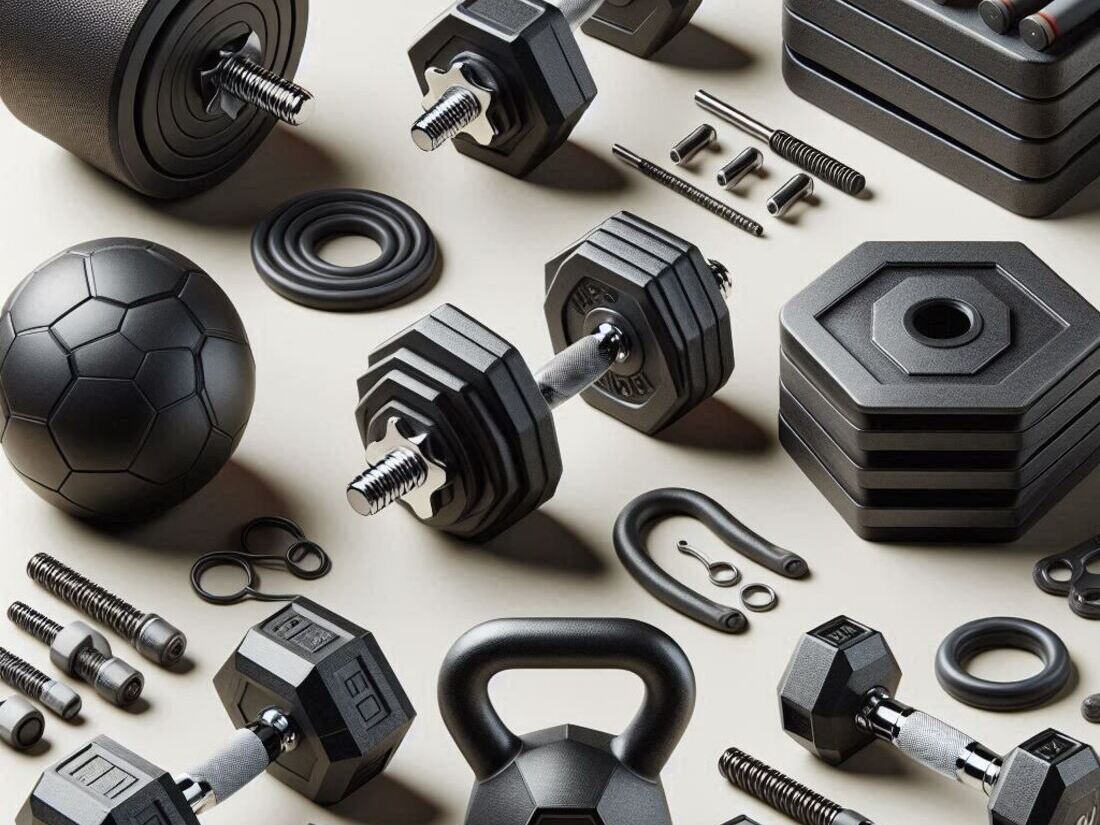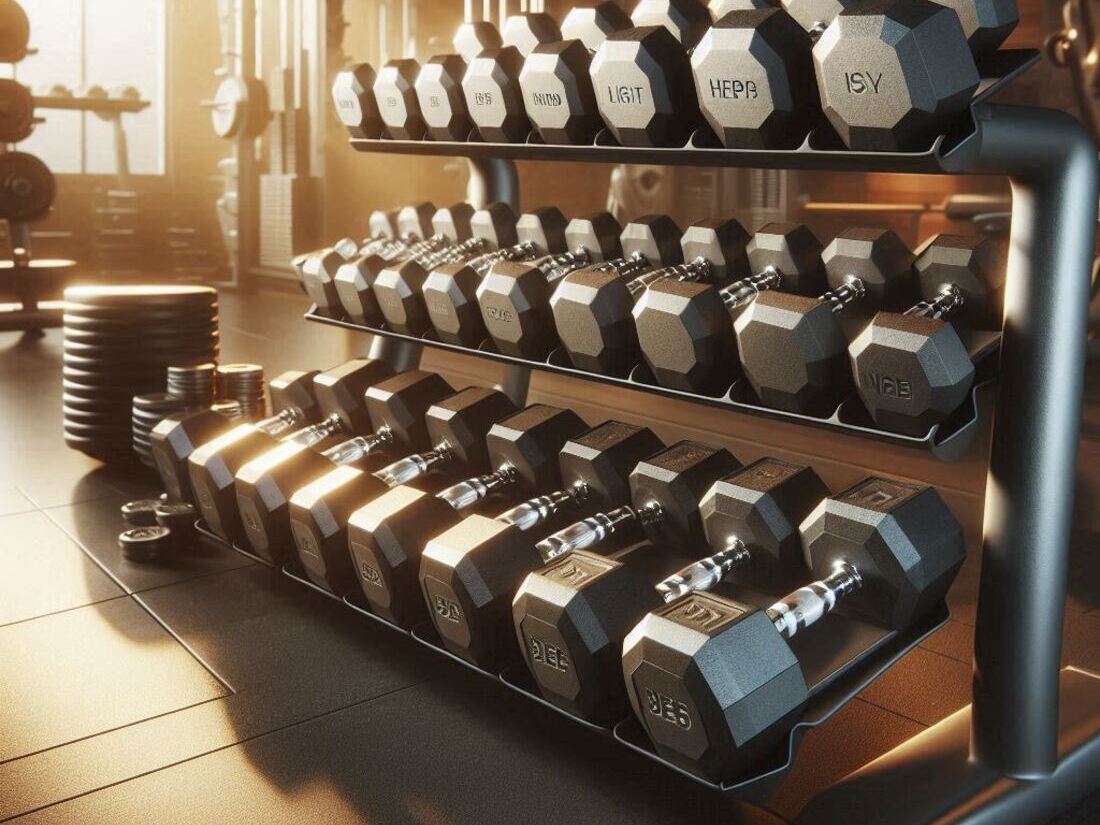Navigating the world of dumbbells can be overwhelming, especially when setting up a home gym.
With countless options in weight and style, it’s easy to feel lost in the dumbbell jungle.
Too many dumbbells can clutter your space, while too few can limit your workout potential.

Let’s unravel this dilemma and help you find the perfect dumbbells to match your fitness goals.
By understanding the different types of dumbbells and factors influencing weight selection, you can create a well-rounded home gym setup that supports your strength-building journey.
Let’s dive in!
Understanding Dumbbell Types

Choosing the right dumbbell type is crucial for optimizing your workout experience.
Let’s explore the key characteristics of different dumbbell options: (Note: Affliate Links)
Rubber-Coated Dumbbells
Rubber-coated dumbbells are popular for their protective features and aesthetic appeal.
- Benefits: Protect floors from damage, reduce noise, and provide a comfortable grip.
- Drawbacks: Can be more expensive than cast iron dumbbells and may have weight limitations.
- Ideal use cases: Home gyms, apartments, and individuals prioritizing noise reduction.
Cast Iron Dumbbells
Cast iron dumbbells are the traditional choice, offering durability and affordability.
- Benefits: Cost-effective, sturdy, and available in a wide range of weights.
- Drawbacks: Can be noisy when dropped and may damage floors.
- Ideal use cases: Weightlifters, powerlifters, and those seeking a budget-friendly option.
Hexagonal Dumbbells
Hexagonal dumbbells prevent rolling, making them ideal for floor exercises and storage.
- Benefits: Stable and space-saving design.
- Drawbacks: Might be limited in weight options compared to cast iron dumbbells.
- Ideal use cases: Home gyms with limited space and individuals who prioritize stability.
Adjustable Dumbbells
Offering versatility and space-saving benefits, adjustable dumbbells allow you to change weight without multiple sets.
- Benefits: Convenient, space-saving, and adaptable to different fitness levels.
- Drawbacks: May not provide the same feel as fixed-weight dumbbells.
- Ideal use cases: Individuals with limited space, budget-conscious lifters, and those seeking variety in workouts.
By understanding the pros and cons of each dumbbell type, you can select the perfect option to suit your home gym and fitness goals.
Determining the Right Dumbbell Weight
Selecting the appropriate dumbbell weight is essential for maximizing your workout’s effectiveness.
Several factors influence this decision:
Factors Influencing Dumbbell Weight Selection
- Fitness level: Beginners may start with lighter weights, while experienced lifters can handle heavier loads.
- Workout goals: Strength training requires heavier weights, while endurance and toning benefit from lighter weights.
- Exercise variety: A range of dumbbell weights is necessary for performing diverse exercises.
Creating a Balanced Dumbbell Set

To cater to different exercises and progression, consider building a balanced set:
- Light weights: For beginners, warm-ups, and high-repetition exercises.
- Medium weights: For general strength training and toning.
- Heavy weights: For challenging workouts and building muscle mass.
Tips for Progressing Weight and Avoiding Plateaus
- Gradual increase: Gradually add weight to your workouts as you get stronger.
- Vary exercises: Challenge your muscles with different movements to prevent plateaus.
- Focus on form: Prioritize correct technique over heavy weights.
- Consider accessory exercises: Incorporate bodyweight exercises or resistance bands for additional challenge.
By carefully considering these factors, you can assemble a dumbbell set that supports your fitness journey and helps you achieve your goals.
Incorporating Dumbbells into Your Workout Routine
Dumbbells are versatile tools that can be integrated into various workout routines.
Let’s explore some effective ways to incorporate them into your fitness regimen:
Sample Dumbbell Workouts

- Beginner: Focus on basic exercises like dumbbell squats, lunges, bicep curls, and tricep extensions.
- Intermediate: Incorporate more challenging exercises like dumbbell rows, overhead press, and deadlifts.
- Advanced: Increase weight and incorporate compound exercises like dumbbell bench press and Romanian deadlifts.
Full-Body Dumbbell Routines
A full-body workout using dumbbells can be highly effective:
- Warm-up: Light cardio, dynamic stretches.
- Workout: Dumbbell squats, lunges, chest press, rows, bicep curls, tricep extensions, overhead press, shoulder press.
- Cool-down: Static stretches.
Combining Dumbbells with Other Equipment

For a more comprehensive workout, combine dumbbells with other equipment:
- Dumbbells and resistance bands: Enhance flexibility and range of motion.
- Dumbbells and kettlebells: Combine strength and cardio for a dynamic workout.
- Dumbbells and bodyweight exercises: Create a challenging circuit routine.
By incorporating dumbbells into your workout routine, you can achieve a well-rounded and effective fitness regimen.
Benefits of Dumbbell Training
Incorporating dumbbells into your workout routine offers a multitude of benefits:
- Muscle development and strength gains: Dumbbells target specific muscle groups, leading to increased strength and definition.
- Improved functional fitness: Dumbbell exercises mimic everyday movements, enhancing functional strength and balance.
- Enhanced balance and coordination: Many dumbbell exercises challenge core stability and overall coordination.
- Versatility and convenience: Dumbbells offer a wide range of exercises and can be used in various workout settings.
By harnessing the power of dumbbells, you can achieve a well-rounded and functional physique.
Dumbbell Storage and Maintenance
Proper storage and maintenance ensure the longevity of your dumbbells:
- Storage tips: Utilize dumbbell racks or stands for organized storage. If space is limited, consider interlocking hexagonal dumbbells. Avoid stacking dumbbells on top of each other to prevent damage.
- Maintenance: Wipe down dumbbells after each use to remove sweat and prevent corrosion. Store them in a dry place to protect against rust. For rubber-coated dumbbells, avoid exposure to extreme temperatures.
By following these tips, you can prolong the life of your dumbbells and maintain a clean workout environment.
FAQs About Dumbbells
To address common questions about dumbbell selection and usage, here are some frequently asked questions:
- What is the best weight to start with for dumbbells?Begin with lighter weights and gradually increase as you build strength. A good starting point is a pair of 5-8 pound dumbbells
- How many pairs of dumbbells do I need? A basic set includes weights ranging from 5 to 25 pounds. You can add heavier weights as you progress.
- Can I build muscle with just dumbbells? Absolutely! Dumbbells offer a versatile way to target different muscle groups and build strength,
- How often should I increase dumbbell weight? Increase weight every 4-6 weeks or when you can comfortably perform 12-15 repetitions with good form.
- Are adjustable dumbbells worth the investment? Adjustable dumbbells save space but might not offer the same feel as fixed-weight dumbbells. Consider your space and budget.
By addressing these common questions, you can provide valuable information to help readers make informed decisions about their dumbbell purchases.
Testimonials
“Investing in a good set of dumbbells was the best decision for my home gym. They’ve helped me build strength and tone without needing to go to the gym.” – Mark, 35
“I love the versatility of dumbbells. I can do everything from light cardio to heavy lifting with just one piece of equipment.” – Sarah, 28
“Adjustable dumbbells have saved me so much space! I can easily switch between different weights for various exercises.” – Alex, 25
These testimonials highlight the benefits and satisfaction experienced by dumbbell users.
Dumbbell Workouts for Specific Goals

- Muscle Building: Focus on compound exercises, heavier weights, and lower repetitions. Incorporate exercises like dumbbell bench press, squats, and rows.
- Weight Loss: Prioritize cardio-based exercises, combining dumbbell workouts with high-intensity intervals. Include exercises like dumbbell burpees, lunges, and alternating front raises.
- Toning: Combine strength training with endurance exercises. Focus on lighter weights and higher repetitions. Include exercises like dumbbell bicep curls, tricep extensions, and shoulder presses.
Dumbbell Accessories
Optional accessories can enhance your dumbbell workouts:
- Dumbbell stands: Keep your dumbbells organized and prevent damage.
- Weight plates: For adjustable dumbbells, provide additional weight options.
- Yoga mats: Protect your floors and provide a comfortable workout surface.
Dumbbell Safety Tips
- Proper form: Prioritize correct technique to prevent injuries.
- Warm-up: Prepare your muscles with light cardio and dynamic stretches.
- Cool-down: Incorporate static stretches to improve flexibility.
- Listen to your body: Avoid overtraining and take rest days when needed.
Comparison of Dumbbell Types
To help you choose the right dumbbells, consider this comparison,
| Feature | Rubber-Coated | Cast Iron | Hexagonal | Adjustable |
|---|---|---|---|---|
| Material | Rubber coated cast iron | Cast iron | Cast iron | Metal or composite |
| Noise Level | Low | High | Medium | Low |
| Durability | High | High | High | Medium |
| Price Range | Medium | Low | Medium | High |
| Versatility | Medium | High | High | High |
| Space Efficiency | Medium | High | High | Highest |
Conclusion
Selecting the right dumbbells is crucial for maximizing your workout potential and achieving your fitness goals.
By considering factors such as dumbbell type, weight, and your specific needs, you can create a well-equipped home gym.
Investing in quality dumbbells empowers you to build strength, improve muscle tone, and enhance overall fitness.
Remember, consistency and proper form are key to unlocking the full benefits of dumbbell training.
Ready to transform your home workouts?
Explore our curated selection of dumbbells to find the perfect match for your fitness journey.
Visit our website Reliable Home Fitness Website to discover more tips and advice on dumbbell training.
References
- National Strength and Conditioning Association (NSCA): BASICS OF STRENGTH AND CONDITIONING MANUAL covers various aspects of training, including program design, exercise technique, and spotting techniques
- American Council on Exercise (ACE): ACE’s Exercise Library features a variety of movements, complete with detailed descriptions and photos.
